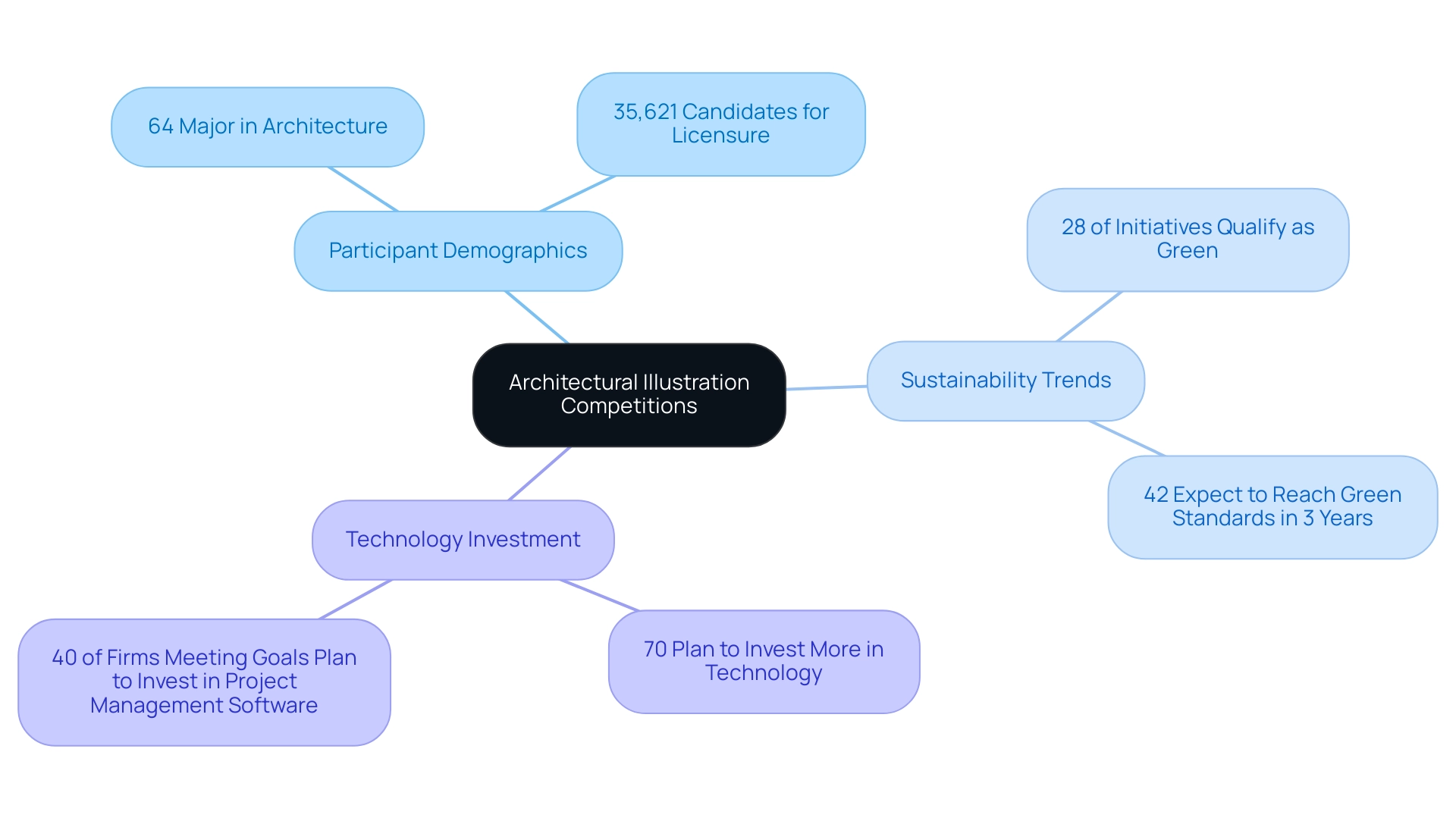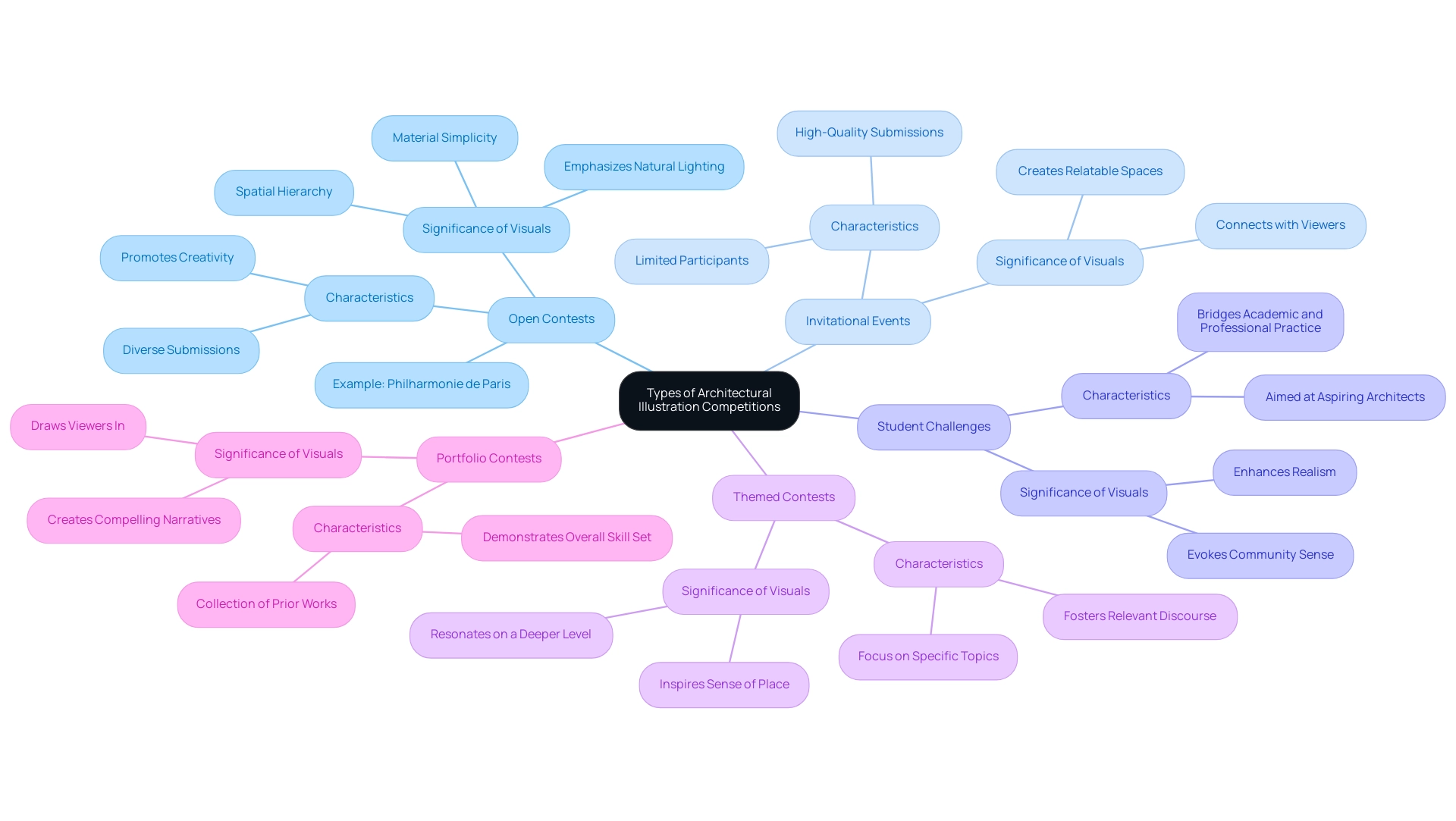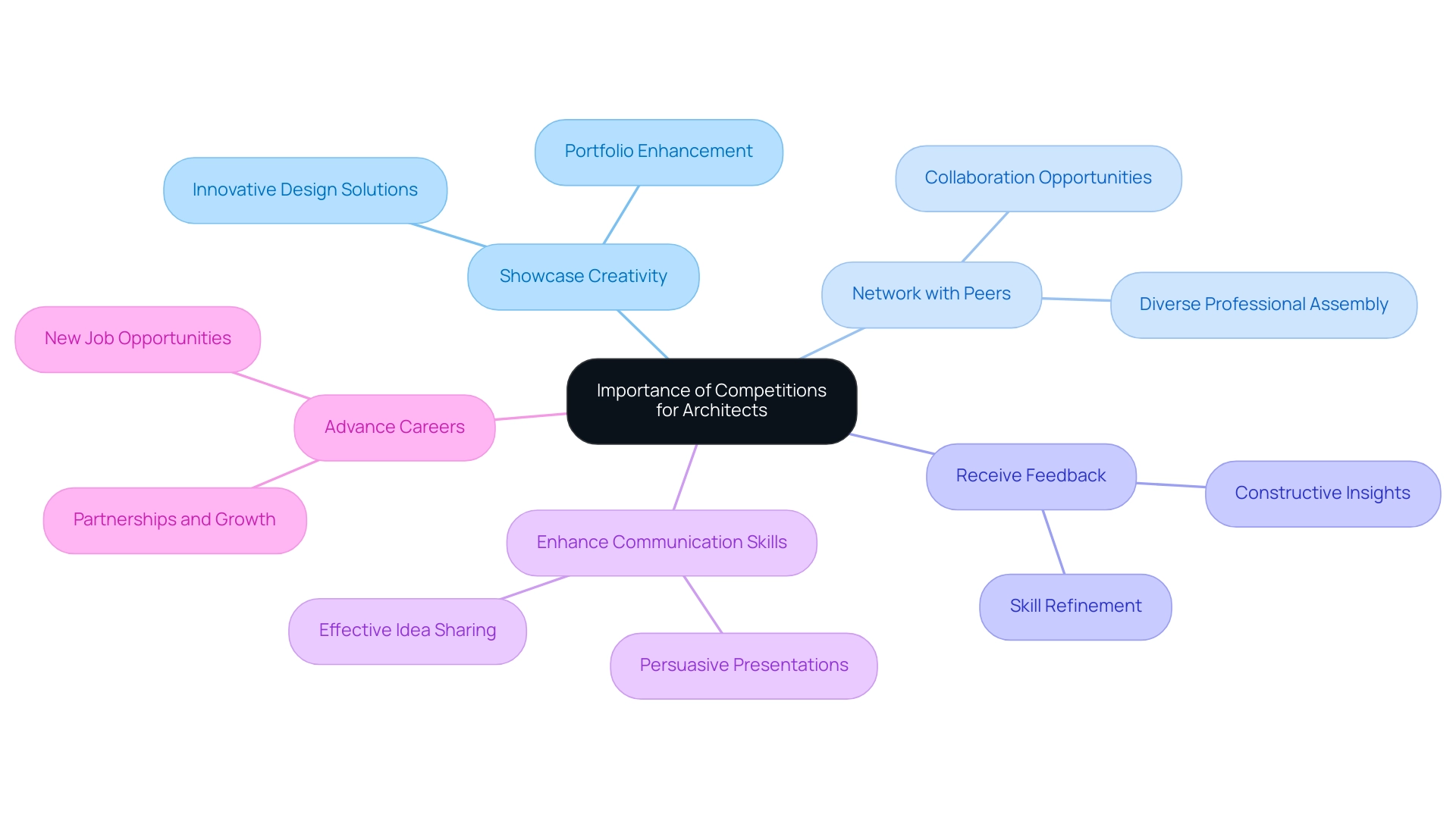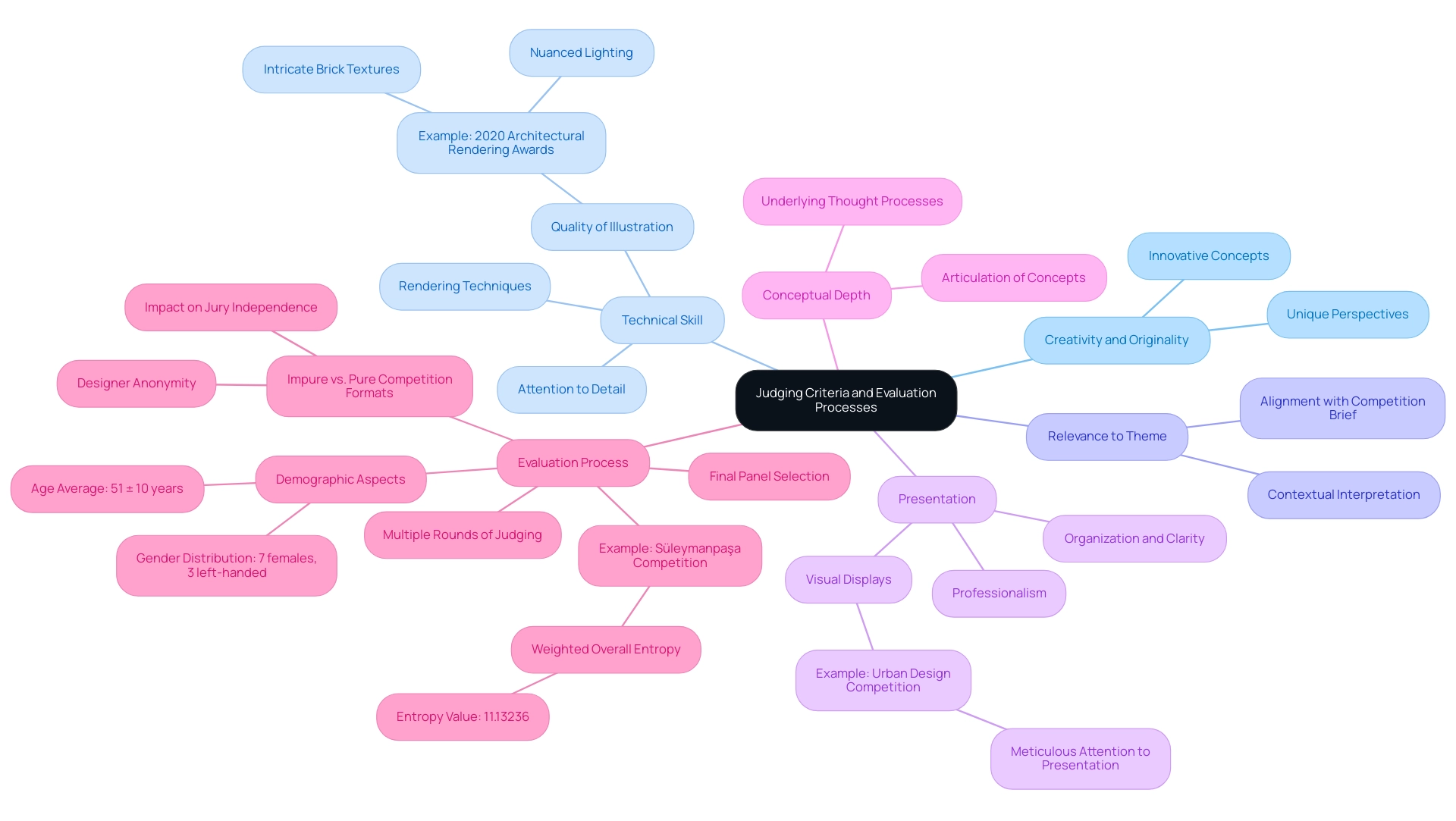Introduction
In the dynamic realm of architecture, illustration competitions serve as pivotal events that transcend mere creative expression, offering architects and designers a platform to showcase their technical prowess and innovative visions. These competitions not only highlight individual artistry but also play a crucial role in shaping professional trajectories, fostering collaboration, and igniting discussions on pressing themes such as sustainability and community engagement.
As the architectural landscape continues to evolve, understanding the various types of competitions—from open and invitational to student and themed—becomes essential for participants aiming to leverage these opportunities for career advancement.
This exploration delves into the significance of architectural illustration competitions, illuminating their impact on both personal growth and the broader architectural discourse.
Defining Architectural Illustration Competitions
Architectural illustration competitions represent a critical juncture for architects, designers, and visualizers to present their artistic renderings and conceptual designs. These events not only showcase creativity and technical expertise but also serve as significant avenues for career advancement. Participants vie for recognition and awards, which can lead to new professional opportunities.
Spanning from local to global contests, these events frequently emphasize particular themes or types of initiatives, thereby promoting a varied and competitive environment. Notably, 64% of staff architects major in architecture, highlighting the educational background of many participants. Additionally, there are presently 35,621 candidates actively pursuing licensure, highlighting the competitive nature of the field and the significance of these contests for emerging professionals.
As the architectural landscape evolves, 28% of global architects, engineers, contractors, owners, and investors indicate that most of their initiatives qualify as green, with 42% expecting to reach this benchmark within three years. This shift in focus reflects a growing trend in architectural illustration competitions, highlighting the increasing prominence of sustainability themes. Moreover, leveraging advanced architectural visualization techniques not only enhances confidence through pre-sales renderings, which serve as a vital revenue-generating tool for construction endeavors, but also fosters a deeper connection with potential residents, setting the foundation for strong community bonds.
These visual aids play an essential role in improving stakeholder communication by offering clear, immersive depictions of initiatives, which can assist in recognizing issues early in the process. A recent case study emphasized that 70% of companies intend to invest more in technology, especially in project management and creative software, highlighting the significance of these events in fostering innovation and professional growth within the field.
Types of Architectural Illustration Competitions
Architectural illustration contests are categorized into several distinct types, each serving unique purposes and participant needs:
Open Contests: These events invite submissions from anyone, fostering a diverse array of innovative ideas and concepts. For instance, the Philharmonie de Paris contest, won by Jean Nouvel in 2011, exemplifies how open contests can yield exceptional designs that emphasize natural lighting, material simplicity, and spatial hierarchy. Such events, like the architectural illustration competition, are intended to promote creativity and new viewpoints, highlighting the importance of high-quality visual representations in architectural vision. The intricate specifics depicted in these visuals not only reflect the designer’s vision but also evoke emotional responses, making the works feel more tangible and welcoming.
Invitational Events: Limited to a select group of participants, invitational events typically involve architects and designers who have demonstrated notable achievements or meet specific criteria set by the organizing body. This exclusivity enables a concentrated examination of concepts and high-quality submissions, highlighting the crucial role of remarkable 3D visuals in project development and decision-making. The specifics in these representations can foster an ambiance that connects with viewers, making the creations feel lived-in and relatable.
Student Challenges: Aimed at aspiring architects, these challenges offer a venue for students to display their skills and acquire significant exposure within the industry. Statistics indicate a growing involvement of students in architectural illustration competitions, highlighting their significance in bridging the gap between academic training and professional practice. Will Plowman from Foster + Partners remarked, ‘The drawings of Saint Colomban radiate great energy and a strong sense of community,’ emphasizing the importance of student contributions in contests and the influence of intricate details in enhancing realism and emotional connection.
Themed Contests: Focused on specific topics—such as sustainable creation, urban planning, or historical preservation—these contests, particularly the architectural illustration competition, challenge participants to address particular issues through their illustrative work, thereby fostering relevant discourse in the architectural community and showcasing the emotional influence of their creations. The meticulous focus on detail in these submissions can inspire a sense of place and purpose, causing the endeavors to resonate on a deeper level.
Portfolio Contests: Participants in these contests submit a collection of their prior works instead of one single piece. This format allows competitors to demonstrate their overall skill set, design philosophy, and personal style, providing a comprehensive view of their capabilities and the intricate details that make each submission compelling. The cumulative effect of these details can create a narrative that draws viewers in, making the projects feel both real and aspirational.
A thorough understanding of these types of contests enables participants to select those that best align with their skills, aspirations, and professional development goals while recognizing the importance of quality renderings in making their projects feel real, lived-in, and impactful.
The Importance of Competitions for Architects
Architectural illustration competitions are instrumental in shaping the professional trajectories of architects and designers. These events serve as a unique platform for participants to engage in various beneficial activities:
- Showcase Creativity: By encouraging architects to stretch their creative boundaries, competitions foster an environment that promotes innovative design solutions. This culture of creativity is essential for pushing the architectural narrative forward. Gaining recognition in the architectural illustration competition—whether through winning or participation—can significantly enhance an architect’s portfolio, elevating their visibility and credibility within the industry. The substantial prize fund of 250,000 € underscores the value placed on these accolades.
- Network with Peers: Such events attract a diverse assembly of professionals, presenting invaluable opportunities for networking and collaboration among peers.
- Receive Feedback: Participants benefit from constructive insights provided by judges and fellow competitors, which are crucial for refining their skills and enhancing their design approach.
- Enhance Communication Skills: Presenting ideas persuasively to judges or panels helps participants improve their communication and presentation skills, which are vital in the architectural field.
- Advance Careers: Success in an architectural illustration competition not only opens doors to new job opportunities but also paves the way for partnerships and further professional growth.
Moreover, high-quality renderings play a crucial role in development and decision-making. They act as a window into the future of your project, enabling all stakeholders to visualize the potential and understand the vision behind the blueprints. This clarity is essential for informed decision-making and building excitement about what’s to come.
As one industry leader noted, ‘Curious about the value of architecture contests?’ Discover the transformative power they can have on your career – from igniting creativity and turning concepts into reality, to gaining international recognition. The impact of these competitions extends beyond immediate accolades; they ignite creativity, facilitate professional development, and provide a transformative experience that architects can leverage throughout their careers.
Additionally, collaborators such as J. Scott Smith Visual Designs can help in visualizing and validating architectural concepts through initial illustrations. Reach out to us today to arrange a consultation and discover how we can help realize your concepts. This collaborative design phase, which includes iterative visuals based on client feedback, is crucial for successful project visualization, allowing for adjustments that align with your vision and needs.
Judging Criteria and Evaluation Processes
The judging criteria for architectural illustration competitions are multifaceted, encompassing several key elements that ensure a comprehensive evaluation of submissions:
- Creativity and Originality: Judges prioritize innovative concepts that distinguish themselves from conventional methodologies, reflecting the designer’s unique perspective.
- Technical Skill: A thorough assessment of rendering techniques, attention to detail, and overall illustration quality is essential, showcasing the designer’s proficiency in their craft. The significance of precision in capturing the essence of a design cannot be overstated, as even the tiniest details contribute to the realism and emotional depth. For instance, in the 2020 Architectural Rendering Awards, a submission that highlighted intricate brick textures and nuanced lighting was praised for its lifelike quality, significantly impacting the judges’ scores.
- Relevance to Theme: Submissions to the architectural illustration competition must demonstrate a clear alignment with the competition’s specified theme or brief, indicating the participant’s ability to interpret and respond to contextual demands effectively.
- Presentation: The organization, clarity, and professionalism of a submission significantly influence judges’ perceptions and can be a determining factor in the evaluation process. High-quality visual displays improve the overall presentation, making designs feel authentic and prepared for construction. Details such as shadow play and material finishes can sway judges’ opinions, as seen in the recent Urban Design Competition, where meticulous attention to presentation led to a higher ranking for several entries.
- Conceptual Depth: Judges evaluate the underlying thought processes behind creations, assessing how effectively concepts are articulated and developed throughout the submission. Meticulous detail in renderings not only informs the design but also plays a crucial role in decision-making for development.
Magnus Rönn, Project Leader, emphasizes that ‘Quality means that the project must operate,’ underscoring the critical importance of quality in the evaluation process of the architectural illustration competition. Typically, the evaluation process consists of multiple rounds, where preliminary judges filter the entries before a final panel makes the ultimate selection of winners. This structured methodology is designed to uphold the integrity and fairness of the architectural illustration competition, as demonstrated by the Süleymanpaşa Contest, which utilized specific weight factors and entropy calculations to ensure a rigorous assessment.
The first-place entry, for instance, achieved a weighted overall entropy of 11.13236, highlighting the competitive nature of the selection process. Additionally, in considering the demographic aspects of participants, it is noteworthy that sixteen controls were matched by age, averaging 51 ± 10 years, with 7 females and 3 left-handed, which can inform the understanding of diversity in submissions.
Furthermore, while impure rivalry formats can address some drawbacks of pure contests, they may compromise jury independence and designer anonymity, raising important questions about the integrity of the evaluation process. Such an approach not only enhances the quality of the contest but also fosters a sense of equity among participants.
Highlighting Notable Competitions and Winners
The architectural landscape is enriched by several prominent architectural illustration competitions that not only celebrate creativity but also significantly influence the careers of those who participate. Among these, the Architizer A+ Awards stands out, recognizing excellence in architecture and design globally. This competition serves as a vital platform for elevating the visibility of remarkable initiatives and professionals, fostering innovation within the industry.
The International Architecture Awards further enhances this recognition by honoring outstanding architectural achievements across diverse categories, showcasing exceptional global talent. Meanwhile, the Render Awards specifically highlight the craft of architectural visualization, offering an essential platform for visualizers to showcase their best visuals and illustrations, which serve as vital instruments for client engagement and specifications.
Top-notch visualizations are akin to a portal into the future of your initiative, enabling all participants to perceive the possibilities and grasp the concept behind the designs.
This clarity is not just beneficial; it is essential for informed decision-making and generating excitement about what’s to come. Notably, the entries in these contests range in age from 15 to 43 years old, reflecting a diverse participant pool that enriches the landscape.
Successful firms and individuals, such as Zaha Hadid Architects and visualizer Alex Hogrefe, have witnessed profound impacts on their careers due to these accolades. As Ricardo Gomes, Partner at KWY.studio, notes, “This visualization convincingly shows the creative process of the development of an idea. It mixes drawing and diagrammatic representation, with detailed illustration of complex machine-like connections and relations between parts.”
This expert opinion underscores the importance of the creative process in architectural visualization.
Moreover, the case study of the Vilnius Guggenheim Hermitage Museum, created by Zaha Hadid and expected to be a cultural landmark, illustrates the significance of remarkable architectural endeavors and the essential role that high-quality visual renderings play in development and decision-making. These instances reflect how participation in architectural illustration competitions advances careers while also highlighting the importance of these competitions in shaping the future of architecture. To see examples of our work and explore more about our 3D Architectural Visualization services, we invite you to visit our portfolio and blog, which offer valuable insights and resources for architects looking to enhance their projects.
Conclusion
Architectural illustration competitions play a vital role in the architecture and design industry, serving as a catalyst for creativity, professional growth, and collaboration. These events not only provide a platform for architects and designers to showcase their artistic and technical abilities but also facilitate networking opportunities and the exchange of innovative ideas. The diverse categories of competitions—from open and invitational to student and themed—cater to a wide range of participants, allowing them to align their submissions with their professional aspirations and areas of expertise.
The significance of these competitions extends beyond personal accolades; they contribute to the broader architectural discourse by emphasizing themes such as sustainability and community engagement. As the demand for high-quality visual renderings increases, participants are encouraged to enhance their technical skills and explore cutting-edge visualization techniques. This focus on excellence not only elevates individual careers but also drives the industry forward, promoting a culture of continuous improvement and innovation.
Ultimately, engaging in architectural illustration competitions can have transformative effects on an architect’s career trajectory. By fostering creativity, providing critical feedback, and enhancing communication skills, these competitions empower architects to realize their visions and contribute meaningfully to the built environment. As the architectural landscape continues to evolve, the role of these competitions will remain integral in shaping the future of design and architecture, making them essential for both emerging and established professionals.





0 Comments